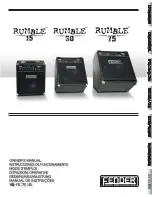
Vincent
37
36
Vincent
If you intend to connect two pairs of speakers, all loudspeakers must have a nominal impedance
of at least 8
Ω
. If only one pair of speakers is used (A or B), all types of loudspeakers with a mini-
mal nominal impedance of 4
Ω
can be utilised.
Consider correct polarity, the positive contact is mostly marked red or with "+". The side of the
speaker cable that has to be connected with the positive socket has a marking.
CONNECTION OF THE LOUDSPEAKERS
CONNECTION OF THE POWER CABLE
Either a single speaker pair (A) or two speaker pairs (A+B) can be connected to the SV-234 amplifier.
Both outputs are identically provided with the stereo signal of the currently selected input source. For each
loudspeaker you will find two connector screws (po und negative -) at the amplifier's backside.
One side of the speaker cable must be attached here. Each pair of screws has a label "R" or "L" nearby
to clarify to which stereo channel it belongs. At the loudspeaker connection terminal there are similar con-
nector screws or connectors. There, the polarity of each screw (+ or -) can be identified as well and the
other side of the speaker cable associated with this speaker must be attached. Make sure only connector
screws of the same polarity will be connected by each speaker cable wire: a knob marked "+" in the
amplifier's terminal must be connected with a speaker's connector screw marked "+" as well. Our sketch
shows all connections necessary for one pair of speakers. If a second pair of loudspeakers is intended to
be used, the connector screws of the lower row (Speakers B) must be connected in a similar fashion to
the additional speakers’ input connectors.
Check whether the wall socket provides the appropriate mains power, which is the case if it is supplied
with 230 V AC 50 Hz. Push the plug on the power cable supplied firmly into the power socket (16) on
the back of the appliance. Plug the other end of the power cable into a mains socket.
If every speaker is connected in a conventional way (a two core speaker cable for each loudspeaker) and
you own loudspeakers that are equipped with Bi-Wiring terminals (four connector screws) you have to make
sure that the metal brackets (contact pieces consisting of small metal plates or short pieces of cable which
are supplied with the speakers) are applied to the terminal and that each one connects the two knobs of the
same polarity (e.g. both connectors marked "+"). The connector screw labelled "+" and "R" at the ampli-
fier's backside must be connected to one of the bridged, labelled "+" connectors of the loudspeaker assi-
gned to the right stereo channel. Accordingly, the connector screw labelled "-" and "R" at the amplifier's
backside must be connected to one of the bridged, labelled "-" connectors of the loudspeaker assigned to
the right stereo channel. Connect the left side loudspeaker in the corresponding way.
If you are using ready made loudspeaker cables with 4 mm banana plugs, all you need to do is connect
the two plugs on each loudspeaker cable end to the two associated speaker connectors. Turn the connec-
tor screws clockwise to fasten them.
If you want to use speaker cables equipped with spade lug connectors, every connector screw must be
opened by turning counterclockwise. After that, the lug must be moved under the screw head. Then, turn
the screw clockwise to fasten the lug to the connector. To avoid damages to the amplifier, make sure the
connection is tight and no bare metal from the cable lug connector makes contact with the rear panel or
with another terminal.
If no connector is to be used, remove approximately 1 cm length of insulation from each end of the spea-
ker wire. Twist the braid in order to avoid short circuits. Turn the fastener on the loudspeaker terminal coun-
terclockwise to loosen it and introduce the bare wire end into the exposed connector hole. Then turn the
fastener clockwise so that the wire is firmly clamped. Make sure the connection is pretty tight.
SV-234
Содержание SV-234
Страница 1: ...t 4 rker ifier r o...
Страница 33: ......















































